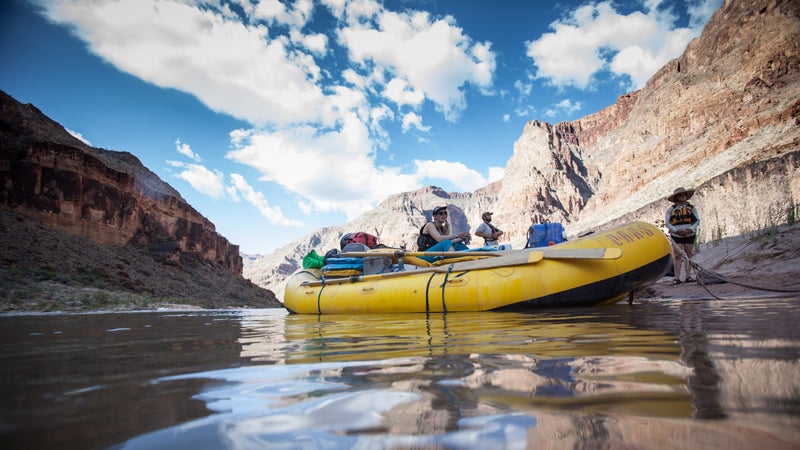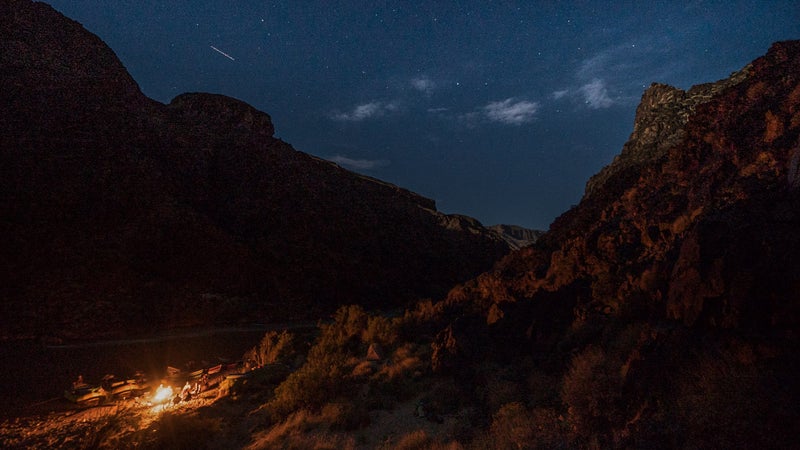River Rules
There are really only two: Keep the boat upright, and preserve the ice at all costs
On the roster of epic wilderness adventures, nothing plays second fiddle to a river trip through the Grand Canyon. The statistics and numbers outline the heart of the matter: a 277-mile odyssey by boat, lasting up to three weeks, along the bottom of a mile-deep abyss听deep inside America鈥檚 most iconic national park and听amid a hidden world of Class听V whitewater framed by ramparts of rock with bloodlines extending more than 17 million centuries into the past.
This is a journey like no other. And although the whitewater at the bottom of the canyon is often advertised as the highlight of the adventure鈥攖his section of the Colorado River is studded with no fewer than 160 rapids鈥攎ost visitors emerge from their experience convinced that it is not the thunderous crescendos听but the subtle grace notes听that render the canyon鈥檚 symphonic merging of water and stone so singular听and so seductive.
The lilting trill of a canyon wren, the prettiest bird on the river. The gossamer scent of a freshly opened claret cup cactus blossom. And always and indelibly, the way the late-evening light听draws out the ochres, pinks, and tints of rose that lurk beneath the skin of the redwall limestone, the most gorgeous of the canyon鈥檚 26 layers of rock, and creates a vast tapestry of color with an iridescence that effortlessly surpasses all the stained glass in all the cathedrals of France.
Over the years, the majority of travelers who have completed this journey have done so at the behest of one of the dozen-odd outfitters licensed to run commercial river trips through the canyon. Each of these companies is staffed by a corps of veteran guides who spent years climbing toward听one of the most coveted jobs in the outdoors听and now sit at the pinnacle of the whitewater world. Every spring, when a crop of young wannabes attempts to break into the ranks by participating in a training trip where their skills will be weighed and judged, the silverbacks like to let the rookies in on a little secret.
Sooner or later, most Grand Canyon guides will find themselves tested by a range of hazards that beset their clients, extending from flash floods and rockfalls to rattlesnakes and scorpions. Keeping people safe and happy in a setting like this can be a challenge. But according to the old-timers, there are really just two rules that you cannot break, the first of which is deceptively simple:听Don鈥檛 flip your boat upside听down.
In the very next breath, the veterans will assure their young charges that this rule is pretty preposterous because, like it or not, everybody flips their boat at least once. It鈥檚 embarrassing and violent听and occasionally quite dangerous. But given the complexity of whitewater, it鈥檚 impossible to avoid.
The biggest rapids鈥攖he hellbenders like Hance and Horn Creek, Granite and Hermit, Crystal and Lava Falls鈥攁re big enough and mercurial enough that even the finest oarsmen will eventually undergo the humiliation of being dump-trucked into the river, along with their passengers and gear, and washed downstream for a long and exceedingly unpleasant swim. In fact, a flip is viewed as an inescapable rite听of听passage in the career of every young river guide. And so, by virtue of this inconvenient truth, it turns out that there is really only one cardinal, unbreakable, iron-clad, indispensibly critical Rule of the River:听Any emergency, even a flipped boat, is surmountable鈥攁s long as you don鈥檛 screw up dinner. 听 听 听 听
From May through August, the inside of the Grand Canyon functions, in effect, like an immense convection oven. For up to 14 hours each day, the rock walls on either side of the river bake beneath the unrelenting glare of the Arizona sun. At night, the heat inside those walls never seems to dissipate. Under the right conditions, the thermometer along virtually the entire length of the river can push as high as 120 degrees and remain there for days, sometimes even weeks. There is no respite. There is no relief. And when it comes to the one thing that is necessary to keep people happy in the midst of adversity鈥攆eeding them a decent meal鈥攖here is no margin for error.
Back in the 1960s, when the river-running industry was just getting off the ground, guides often failed to appreciate how important this could be. In those days, the commissary consisted mainly of canned goods鈥攂aked beans, stewed tomatoes, Vienna sausages, and, for dessert, fruit cocktail. One of the earliest guides was a woman named Georgie White, who was famous for three things: the leopard-skin bathing suit she wore every day on the river (replete with its very own tail!),听the construction worker鈥檚 hard hat that she strapped onto her head at the top of every big rapid,听and the appalling grub she slung at听her clients.

听
Every night in camp, one of Georgie鈥檚 assistants got dinner going by hauling out an inflatable kiddie听pool, filling the thing with hot water, and dumping that day鈥檚 ration of tin cans into the mix. A few minutes later, each person was permitted to reach into the lukewarm water and fish out a single can. Whatever you grabbed was your supper, although trading was permitted. (Georgie, who was no dummy, took the precautionary step of preceding each of these meals with a generous cocktail-hour serving of 鈥淪tupid,鈥� a drink that involved mixing Kool-Aid with massive amounts of grain alcohol.)
Today, it鈥檚 a very different story. River trips through the canyon are still defined by adventure, with plenty of hiking and whitewater, as well as the ever-present possibility of a flip. But the time one spends in camp is now more of a gourmet affair. Each evening, as the sun prepares to disappear beyond the rimrock and the stars emerge overhead, the guides are busy in their makeshift kitchens whipping up concoctions that include grilled pork tenderloins, fire-roasted medallions of lamb with mango salsa, and pesto adorned with shrimp over fettuccine.
The听key to all of that鈥攑lus the milk, eggs, and fresh fruit that will festoon the breakfast table the following morning when the sun reappears on the opposite canyon wall鈥攈inges on beating the heat and keeping things cool.
An oar-powered Grand Canyon expedition typically consists of 16 passengers served by a crew of seven guides, whose boats are responsible for transporting, in addition听to the clients, all of the gear and supplies necessary to sustain everyone for up to 18 days. Along with the tents, propane, kitchen equipment, and repair kit (for a list of our favorite Grand Canyon trip essentials, click here)听are six extra-thick听rotomolded polyethylene coolers that, like , are equipped with gasket-sealed lids and walls of pressure-injected foam. Each cooler听contains up to ten inches of solid ice on the bottom, is crammed with food, and tips the scales at more than 300 pounds.
The heaviest cooler听is reserved exclusively for steaks, chicken, sausage, bacon, and other cuts of meat. There are also two dairy coolers, plus a pair of vegetable coolers. Together, they contain a range of products extending from butter, salad dressing, and cheese to lettuce, broccoli, carrots, celery, and tomatoes, along with a variety of melons. Finally, a fifth unit holds all the food needed for the first five days of the trip, which ensures that the other four coolers can remain tightly sealed until the end of the first week.

听
Even with all that insulating power, you still have to crack the lid as seldom as possible to maintain a low temperature inside a cooler. Ideally, each cooler is opened no more than twice a day鈥攅arly in the morning and again in the evening. The procedure is carefully choreographed and involves at least two guides, one of whom counts to three before raising the lid about six inches, just enough for the other guide to stick both hands inside, grab whatever is needed, and pull back before the lid comes crashing down. (Tip for aspiring river guides: One of the fastest ways to get yourself fired is to casually throw open the cooler听lid and stand there in a state of mindless, bovine contemplation while you decide what to select for dinner.)
During the hottest months in the canyon鈥擩une, July, and the first part of August鈥攆ailing to adhere to proper cooler protocol is the best way to guarantee that you will lose all of your ice, and with it, any hope of keeping your food from spoiling. But with attention and care, and the superinsulating properties of a Yeti, it鈥檚 now possible to do things that Georgie White and her contemporaries never would have dreamed听of doing. These days, it鈥檚 not uncommon to set up camp at Stone Creek鈥攁 lovely stretch of sand beach almost halfway between Lee鈥檚 Ferry and the Grand Wash Cliffs鈥攆inish eating dinner, and watch in amazement as the cooks pulls out a box of Snickers Ice Cream Bars or a serving of frozen yogurt popsicles.
That鈥檚 pretty impressive. But the gold standard is this:听At the end of each trip, the river crew piles all of their boats and gear onto a huge truck and settles in for a five-hour drive from the pullout at Lake Mead back to Flagstaff for the 鈥渄e-rig,鈥� a laborious process of cleaning all the gear and provisioning for the next trip. But just as the truck comes to a halt in front of the boathouse, everyone pauses for an important test of the youngest guide.

While everyone else watches, the newbie clambers into the back of the truck, reaches into the cooler that came through the canyon on his or her boat, and pulls out a six-pack of beer. If the rookie is lucky, the six-pack will have spent the entire drive marinating in a half-frozen slush that is still studded with solid chunks of ice.
The bottles are opened, and everyone takes a deep swig, followed by a shockingly chilled, satisfying swallow. And then, together, they slam down the empty longnecks and turn to the task at hand.
There is much to be done before the fall of night. At dawn, the entire crew,听including the rookie,听will head back for Lee鈥檚 Ferry to put the boats in the water, point their bows downstream, and start the cycle again.

